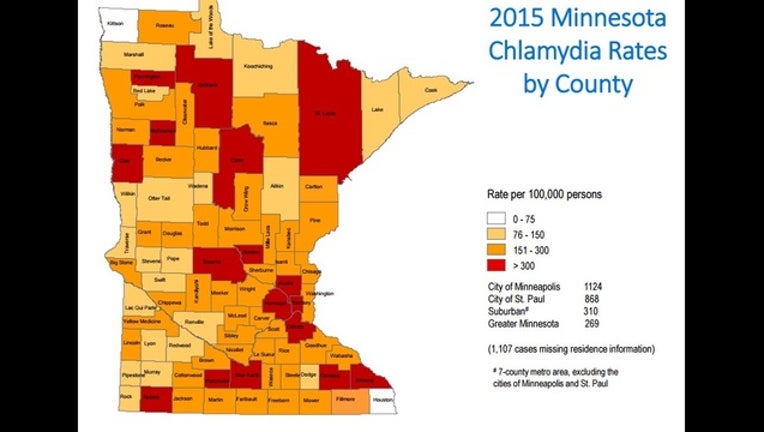STDs in Minnesota hit all-time high, chlamydia most common

ST. PAUL, Minn. (KMSP) - The number of sexually transmitted diseases diagnosed in Minnesota increased 6 percent from 2014 to 2015, hitting an all-time high of 25,986. According to Minnesota Department of Health statistics, chlamydia is the most commonly reported STD and the most-reported infectious disease in the state.
“This disturbingly high rate of growth in the number of STD cases shows the need for improved education about STDs among both the general public and healthcare providers,” said Dr. Ed Ehlinger, Minnesota Commissioner of Health. “These rates also provide further evidence that eroding basic local public health services not only hurts our ability to respond to intractable problems like STDs, but also to emerging infectious diseases like Zika virus.”
STDs in Minnesota
Chlamydia reached a new high of 21,238 cases in 2015 compared to 19,897 in 2014. The majority of cases occurred in teens and young adults. At least 3 cases were reported in every Minnesota county.
Gonorrhea remains the second most-reported STD in Minnesota, with 4,097 cases reported in 2015 compared to 4,073 in 2014. Nearly half (46 percent) all gonorrhea cases occurred among the 15 to 24 age range, and 77 percent of cases occurred in the Twin Cities metro.
Syphilis cases increased to 654 in 2015 from 629 in 2014. A new concern at the health department is a 70 percent increase in syphilis cases among women. New syphilis infections continued to be concentrated within the Twin Cities metro.
Higher rates in communities of color
The STD report shows higher infection rates for chlamydia and gonorrhea among communities of color and American Indians. Higher syphilis rates were seen among American Indian and African American women, and male-male relationships of all races.
Prevent STDs
Ways to prevent getting or spreading STDs include abstaining from sex, limiting the number of sexual partners, always using latex condoms the right way during sex and not sharing needles for drug use, piercing or tattooing.
Get tested
Testing, diagnosing and treating STDs in their early stages are critical to preventing the spread of STDs. Since most STDs don’t show symptoms, it’s important for sexually active people to get tested each year or when involved with a new partner. In addition to yearly exams, health care providers should look for additional opportunities to provide screening. This is especially important for younger patients who may not have yearly check-ups. Confidential information and testing locations are available from the Minnesota Family Planning and STD Hotline at 1-800-78-FACTS (voice or TTY), 651-645-9360 (Metro area), Text ASKMN to 66746 or visit their website at http://sexualhealthmn.org.

